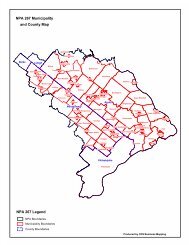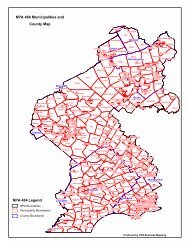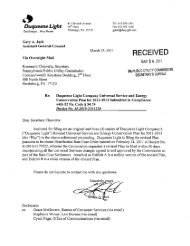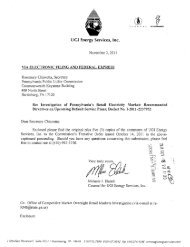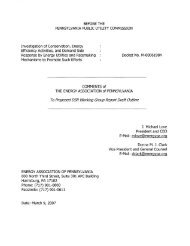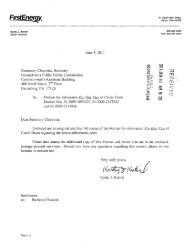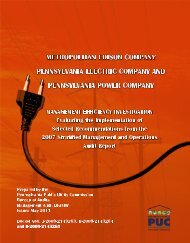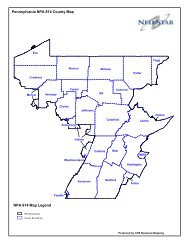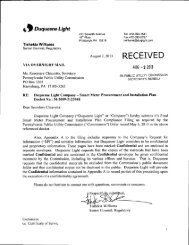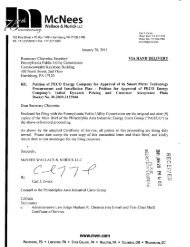2010 Report - Pennsylvania Public Utility Commission
2010 Report - Pennsylvania Public Utility Commission
2010 Report - Pennsylvania Public Utility Commission
You also want an ePaper? Increase the reach of your titles
YUMPU automatically turns print PDFs into web optimized ePapers that Google loves.
PPL's 2009 summer peak load, occurring on Aug. 17, <strong>2010</strong>, was 6,845 MW compared to theprevious summer’s peak of 7,316 MW, or a 6.4 percent decrease. The 2009-10 winter peak loadwas 6,800 MW, representing a decrease of 8.3 percent from last year's winter peak of 7,414 MW.The actual average annual peak load growth rate over the past 15 years was 0.3 percent. PPL’sfive-year winter peak load forecast scenario shows the peak load increasing from 6,845 MW in2009 to 7,487 MW in 2014 at an overall average annual rate of 1.8 percent. The current forecastfor <strong>2010</strong> is 43 MW or 0.6 percent lower than the previous forecast. It is noted that PPL is normallywinter peaking, but in some years the summer peak has exceeded the previous winter peak; thecurrent forecast represents the annual peak load. See Figure 40.Figure 41 depicts the average of deviations in forecasts made one to three years in advance. TablesA17-A20 in Appendix A provide PPL’s forecasts of peak load and residential, commercial andindustrial energy demand, filed with the <strong>Commission</strong> in years 2000 through <strong>2010</strong>.Net operable generating capacity of 8,505 MW (summer rating) for 2009 included 40.6 percentcoal-fired capacity and 25.1 percent nuclear capacity. Natural gas and dual fuel units account for27.0 percent of the total. This capacity, previously owned by PPL, is now owned by a PPLaffiliate, PPL Generation LLC. Independent power producers also provided 6 MW to the system.In 2009, PPL purchased 1,091 GWh from cogeneration and independent power productionfacilities, or 2.7 percent of net energy for load.For Calendar Year 2009, no EGSs supplied energy to retail customers in PPL’s service territory.However, with the removal of rate caps on Jan. 1, <strong>2010</strong>, alternative suppliers were serving 47.5percent of customer load as of April 1, <strong>2010</strong>. 61PPL has identified several transmission projects, including new construction and rebuilding ofexisting lines, with in-service dates through 2020. The projects involve 562 circuit miles at a totalcost of $937.2 million. The single largest project is the Susquehanna-Roseland Project, describedin Section 1.PPL reported a 2009 peak load reduction of 81.8 MW and energy savings of 3,048 MWh resultingfrom its Interruptible Service – Economic Provisions tariff schedule. Customers reducing load foreconomic conditions receive significant rate discounts. The peak load reduction from this programrepresents 1.2 percent of the 2009 summer peak load. PPL’s Price Response Service permitscustomers to respond to market price signals by reducing a portion of their load. In 2009, a 14.6MW peak load reduction was achieved, with energy savings totaling 396 MWh.PPL’s Energy Efficiency and Conservation Plan 62 includes a range of energy efficiency anddemand response programs that include all customer segments, designed to reach cumulativereduction targets of 1,146 GWh and 297 MW at a total cost of $246 million.PPL is a member of PJM and RFC.61 <strong>Pennsylvania</strong> Office of Consumer Advocate.62 Docket No. M-2009-2093216.Electric Power Outlook for <strong>Pennsylvania</strong> 2009-2014 45



